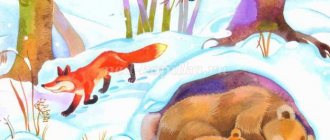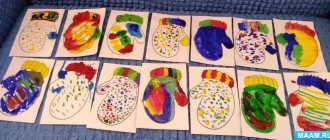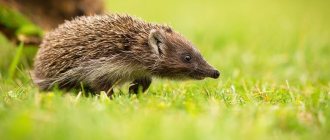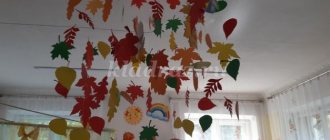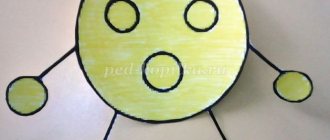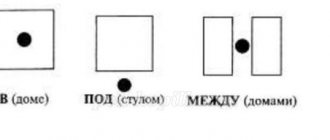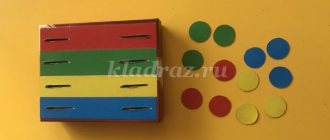Summary of a lesson on cognitive development in the second junior group on a winter theme
Summary of educational activities in kindergarten in the second junior group on cognitive development on the winter theme “Forest, how many miracles live in it!”
Author: Galina Viktorovna Malenkina, teacher, Municipal State Preschool Educational Institution “Kindergarten No. 4”, Korenevsky district, Kursk region Description of work: The summary will be of interest to preschool teachers, students of the pedagogical college, and parents. Goal: To form children’s ideas about seasonal changes in the life of the forest and wild animals in winter. Educational objectives: - continue to introduce children to the life of wild animals in winter (hare, bear, wolf). - Learn from the ecological ai-stopper (sign) to recognize and tell what this sign means. — Consolidate knowledge about the trees of our strip (oak, maple, spruce); - continue to introduce children to the leaves and seeds of these trees (leaf: maple, oak; fir cone). — Expand children’s understanding of the season - winter, and the properties of snow. Developmental tasks: - develop children's vocabulary; motor activity. — To encourage children to show a desire to decorate crafts. — Develop children’s ability to act with plastic material (kneading, rolling lumps in a circular motion between the palms (a lump of snow), rolling out a small piece with the tips of two fingers (snow). Educational objectives: to cultivate interest in understanding the world around them, showing care and attention to natural objects (animals, plants). Methods and techniques: methods:
visual; practical; game educational situations - travel; modeling; Ecological eye-stopper.
Techniques:
goal setting, questions, instructions, additions, signs, encouragement, showing methods of action.
Materials and equipment: forest (trees, artificial spruce trees; toys: hare, wolf; bear’s den.) TSO – audio recording: song “Bunny” (words: G. Lebedev, music: E. Zhdanova); music. Game “Legs Walked” ( music and lyrics by S. Korotaeva); p/i “Hares and the Wolf”. Layout “Village Yard”; For making artificial snow: soda ash, shaving foam. Oilcloths for each child, napkins. Vocabulary work: activation of the dictionary: wood, spruce, oak, maple. Enrichment of vocabulary: spruce, maple, oak. Preliminary work: a selection of works with descriptions of the forest and its inhabitants, demonstration material “Wild Animals”, “Trees of Our Strip”, listening to children's and folk songs on the topic.
Progress of educational activities
Educator: Guys, have you ever been to the forest? (children's answers)
.
Do you want to visit there again? (children's answers)
.
Fine. Then today you and I will go for a walk in the forest. There, I hope, we will meet forest dwellers. Since we are going to visit forest dwellers, it would be nice to take some treats. Look how many fruits, vegetables and sweets there are here. What will we take? (put carrots, cabbage, and a barrel of honey in the basket)
.
So we go into the forest. Musical game “Legs Walked” (perform movements to the text)
.
Educator: So we came to the forest. (sounds of the winter forest sound: the howl of the wind, the noise of the trees)
.
Guys, what do you hear? (children's answers)
.
Well, the wind died down, it became light and clear. Educator: Do you know who lives in the forest? (children's answers)
.
Let's look for the forest inhabitants. What did you see on the tree? There is a sign on the tree with a picture of a hare holding a carrot in its paws. What does this sign tell us? (children's answers)
.
Yes, that's right, a bunny lives here. Where is he hiding? And, here he is, settled on a stump. Guys, the cowardly bunny is afraid of us, so let's not scream and scare him. (audio recording starts - the bunny talks about himself)
.
Got it, bunny. Guys, the bunny wants to make friends with us and allows us to pet him. (we stroke the bunny)
.
Educator: - Children, the bunny wants to play with us. Look how many beautiful leaves and cones he collected in the fall! These leaves flew from the trees in the fall, and even from the strong wind many cones fell. Look at this leaf from an oak tree, it’s called an oak leaf. And this leaf from a maple tree is called maple. What's in my hands? (children's answers)
.
That's right, bump. What kind of tree do these cones grow on? (children's answers - spruce, Christmas tree)
.
Right. The bunny invites us to play the game “Which branch are the kids from?” I will give you leaves, some will have oak leaves, some will have maple leaves, and some will have a pine cone. Look carefully where the Christmas tree is, where the oak and maple are. When I give you a sign, you must run to the tree from which your leaf fell. It's clear? Then get ready. The breeze swirled the leaves. - Children, fly to your branches! Well done, everyone found their branches correctly. Educator: Guys, we had so much fun playing! And the bunny really liked it. Well, let's say goodbye to the bunny and move on. But first, let's treat the bunny. What shall we treat the bunny? Why? (because the bunny loves carrots and cabbage)
.
Goodbye, bunny! Educator: Let's continue our walk. See what other signs you see? (sign: bear, with a barrel of honey)
.
Where does he live? What does he do in winter? (sleeping in a den)
.
Where is his den? (we find the “den”)
.
What does a bear like? (children's answers)
.
Since the bear sleeps in winter, we won’t wake him up, we won’t make any noise, but we’ll leave him a barrel of honey; when he wakes up in the spring, he’ll eat it. Fine? (children's answers)
.
Guys, look at this sign, what does it tell us? (children's answers)
.
What are you hearing now? (wolf howl)
.
I think a wolf is coming here. I figured out how to outwit the wolf. We will turn into bunnies, play with the wolf, and since bunnies run very fast, we can easily run away from the wolf. Fine? So, you and I are bunnies. Outdoor game "Hares and wolves". Educator: Well, so we ran away from the wolf. Guys, why are forest animals and people afraid of the wolf? (children's answers)
.
It's good that we ran away, right? So we left the forest. Did you like it in the forest? What did you like most? (children's answers)
.
Educator: Look, I have such a beautiful house, trees. But something is missing in this composition. I know what. After all, it’s winter now, and there’s no snow here at all. Let's decorate this composition with snow? I have a snowball, but not a real one, but a magical one that doesn’t melt, and it’s not cold at all. Try how soft it is. If we brought real snow into the garden, what would happen to it? (children's answers)
.
Yes, of course, it would melt and turn into water. You can sculpt from this magical snow like plasticine. Let's try? You can make snow balls from snow, and also sprinkle snow on paths, the roof of a house and trees. (we do the work)
.
Educator: Look what a beautiful winter craft we made! Did you like sculpting from magical snow? What did you like about the forest? What animals did we meet in the forest? Why didn't we see the bear? (children's answers)
.
Educator: I also liked our lesson, we visited the forest, met the forest inhabitants and decorated such a wonderful craft.
We recommend watching:
OD summary on sensory development in the junior group on the topic: Winter Summary of a lesson in the 2nd junior group on the topic: Winter Summary of a lesson on cognitive development in the 2nd junior group on the topic: Winter Summary of a lesson on speech development on the topic: Winter in the 2nd junior group
Similar articles:
Summary of a game lesson for young children on the topic: Winter
